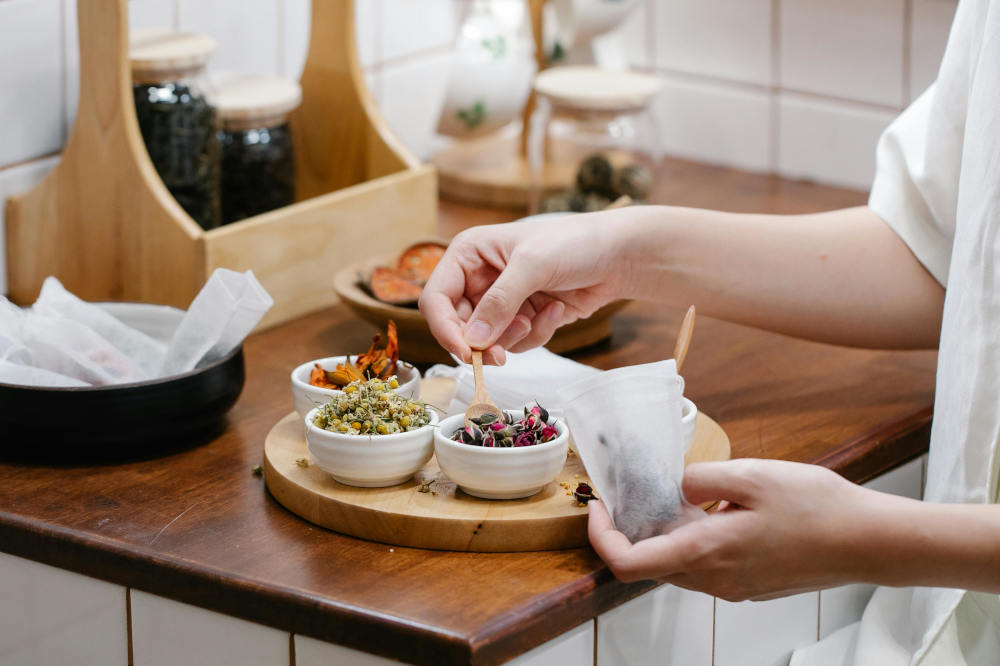
Drying your own leaves for tea is a rewarding and practical way to preserve the freshness, flavor, and healing properties of herbs from your garden or local harvest. Whether you're working with mint, chamomile, lemon balm, or other herbal plants, the process of drying leaves naturally is both simple and sustainable.
In this guide, you'll learn how to dry tea leaves naturally, from harvesting at the right time to using age-old air-drying methods, and how to store your dried herbs properly for long-lasting flavor and benefits.
Panaprium is independent and reader supported. If you buy something through our link, we may earn a commission. If you can, please support us on a monthly basis. It takes less than a minute to set up, and you will be making a big impact every single month. Thank you!
Why Dry Tea Leaves at Home?
Drying your own herbs for tea has several benefits:
-
Preserves nutrients and flavor naturally, without additives.
-
Reduces waste and reliance on store-bought products.
-
Saves money in the long run.
-
Enhances your connection to the herbs and the tea-making process.
-
Offers customization, allowing you to create your own unique tea blends.
Whether you’re an herbalist, tea lover, or home gardener, natural drying is one of the best ways to preserve your harvest.
Best Herbs to Dry for Tea
While nearly any edible leafy plant can be dried for tea, here are some of the most popular and beneficial:
-
Mint (Peppermint, Spearmint) – digestion and cooling effect
-
Lemon Balm – calming and stress relief
-
Chamomile – sleep support
-
Lavender – relaxation and aromatherapy
-
Nettle – nutrient-rich and detoxifying
-
Tulsi (Holy Basil) – adaptogen and immune support
-
Sage – antimicrobial and hormone balancing
-
Thyme – respiratory support
-
Rosemary – mental clarity and memory
-
Echinacea – immune booster
-
Lemongrass – anti-inflammatory and citrus flavor
-
Dandelion Leaves – liver support and detox
Step 1: Harvesting the Leaves
🌿 When to Harvest
-
Morning, after dew dries but before the sun gets too hot (around 9–11 AM), is ideal. This preserves the plant’s essential oils, which give flavor and medicinal properties.
-
Choose healthy, pest-free leaves with no signs of disease or damage.
-
For flowering herbs like chamomile or lavender, harvest flowers at peak bloom.
🌿 How to Harvest
-
Use sharp scissors or garden shears to prevent bruising.
-
Avoid pulling or tearing leaves by hand.
-
Harvest just before flowering for the most potent flavor (especially for mint and lemon balm).
-
Leave enough plant behind so it can regrow.
Step 2: Preparing the Leaves for Drying
-
Rinse leaves gently in cold water to remove dirt, dust, or insects.
-
Pat dry with a clean towel or use a salad spinner to remove excess moisture.
-
Spread them out in a single layer on a towel or paper towel to air-dry completely before the next step. Any residual moisture can cause mold during drying.
Step 3: Natural Drying Methods
🌬️ 1. Air Drying (Hang Drying)
Best for: sturdy herbs like mint, lemon balm, thyme, sage, and rosemary.
Instructions:
-
Gather leaves into small bundles (not too thick).
-
Tie stems together with string, twine, or a rubber band.
-
Hang upside down in a warm, dry, and well-ventilated space out of direct sunlight (like a pantry, attic, or closet).
-
Ensure good airflow to prevent mold.
-
Let dry for 1 to 2 weeks, depending on humidity.
🧺 2. Basket or Tray Drying
Best for: delicate herbs like chamomile flowers, lavender buds, or small leaves.
Instructions:
-
Spread leaves or flowers in a single layer on a mesh screen, drying rack, or paper towel.
-
Place in a well-ventilated space away from direct light.
-
Turn the leaves every day to ensure even drying.
-
Takes 5 to 10 days depending on size and moisture content.
☀️ 3. Sun Drying (Caution Advised)
Best for: dry climates with minimal humidity.
Instructions:
-
Place leaves on a clean tray or mesh screen.
-
Cover with a thin cloth or net to protect from insects.
-
Place in a sunny spot for a few hours, then move to shade to prevent essential oil loss.
-
Not ideal for herbs that lose potency in direct sunlight (like basil or mint).
Step 4: How to Tell When Leaves Are Dry
Properly dried leaves will:
-
Feel crispy and crumbly to the touch.
-
Snap easily when bent (rather than bend or feel leathery).
-
Have a concentrated aroma when crushed.
Avoid drying too long or in overly warm conditions, as this can degrade aroma and potency.
Step 5: Storing Your Dried Tea Leaves
🫙 Storage Containers
-
Use airtight glass jars (mason jars are perfect).
-
Metal tins or food-safe paper bags with closures can also work.
-
Avoid plastic containers, which can leach chemicals or absorb aromas.
🌫️ Storage Environment
-
Store in a cool, dark, and dry place—a pantry or cupboard is ideal.
-
Keep away from heat sources, direct light, and moisture.
-
Label each container with the name of the herb and date of drying.
⏳ Shelf Life
-
Most dried herbs stay fresh for 6 to 12 months.
-
Discard if they lose color, smell stale, or show signs of mold.
Tips for Success
-
Don't overcrowd your herbs. Air circulation is key to preventing mold.
-
Harvest often and in small batches to maintain freshness.
-
Combine drying methods if needed. For example, air-dry the bulk, then finish with a short time in a dehydrator if humidity is high.
-
Keep herbs whole until you’re ready to use—this helps retain flavor longer.
-
Crush just before steeping for maximum aroma and benefits.
Making Tea with Your Dried Leaves
Once your herbs are fully dried and stored, you’re ready to brew!
☕ Basic Herbal Tea Recipe
-
1–2 teaspoons of dried leaves per 8 oz cup of water.
-
Pour boiling water over the herbs.
-
Cover and steep for 5 to 10 minutes, depending on desired strength.
-
Strain and enjoy!
🌸 Blending Ideas
-
Relaxation Blend: Chamomile + Lavender + Lemon Balm
-
Digestion Blend: Peppermint + Fennel + Ginger
-
Detox Blend: Nettle + Dandelion Leaf + Lemon Balm
-
Immune Support: Echinacea + Elderflower + Thyme
Drying your own leaves means you can experiment with blends based on your needs and preferences.
Common Mistakes to Avoid
-
Drying herbs in a humid space: This leads to mold and poor results.
-
Exposing to direct sunlight too long: It can destroy essential oils.
-
Packing herbs before fully dry: Moisture trapped inside will cause mold.
-
Using wet leaves in jars: Always ensure herbs are completely dry before storing.
Conclusion
Drying tea leaves naturally is a simple, rewarding process that brings you closer to the plants you consume. From mint and chamomile to tulsi and nettle, every herb you dry preserves not only flavor and aroma but also wellness benefits that can be enjoyed all year long.
By harvesting carefully, drying with patience, and storing herbs properly, you ensure that every cup of tea is full of intention, health, and taste. Whether you're sipping to relax, energize, or heal, there's something magical about brewing tea from herbs you've lovingly dried yourself.
Was this article helpful to you? Please tell us what you liked or didn't like in the comments below.
About the Author: Alex Assoune
What We're Up Against
Multinational corporations overproducing cheap products in the poorest countries.
Huge factories with sweatshop-like conditions underpaying workers.
Media conglomerates promoting unethical, unsustainable products.
Bad actors encouraging overconsumption through oblivious behavior.
- - - -
Thankfully, we've got our supporters, including you.
Panaprium is funded by readers like you who want to join us in our mission to make the world entirely sustainable.
If you can, please support us on a monthly basis. It takes less than a minute to set up, and you will be making a big impact every single month. Thank you.































0 comments